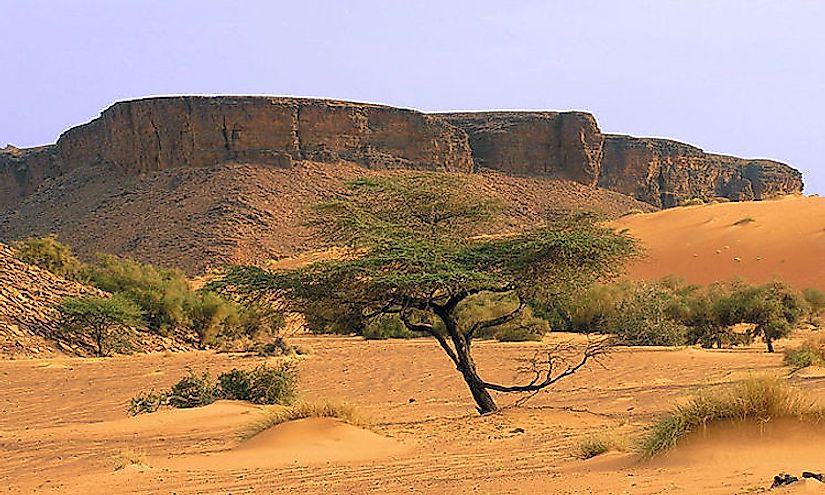Ecological Regions Of Mauritania

Mauritania, one of the 30 largest countries, is predominantly desert or semiarid, with a sizable Atlantic Coast. Mauritania is a country located in West Africa and borders four other African countries of Western Sahara, Algeria, Senegal, and Mali. The country is considered to be part of both the West Africa’s Sahel region and Maghreb region of North Africa covering a total area of 397, 685 square miles.
Ecological Regions Of Mauritania
Atlantic Coastal Desert
The Atlantic coastal desert ecoregion, classified in the desert and xeric shrublands Biome, occupies a small area near the Mauritian Atlantic Coast. The region’s landscape is characterized by cliffs, about 20 to 50 meters tall and sandy plateaus in the inland area. The ecoregion’s climate is hot and arid, with little and sporadic rainfall. Annual precipitation is recorded at 40 mm although years may pass without any rain. Mists are blown offshore by wind currents and after condensation facilitate the growth of lichens and shrubs. This ecoregion provides a habitat for numerous migrating shorebirds and the endangered Mediterranean monk seal. Although rich in endemic plants, the ecoregion has only one endemic fauna, the Algerian snake. Terrestrial fauna which abounds in the region is the hyena, sand fox, ratel, golden jackal and Dorcas gazelle. This ecoregion has continually been degraded due to overgrazing and extended periods of drought. The Réserve Intégrale de Cap Blanc and the Banc d’Arguin National Park were established to preserve the region’s integrity.
Sahelian Acacia Savanna
The Sahelian Acacia savanna ecoregion is classified in the tropical and subtropical grasslands, savannas, and shrublands Biome. This ecoregion stretches along the Atlantic Coast of Mauritania. The region has a flat topography and a hot, tropical climate. Annual rainfall is recorded between 200mm in the north and 600 mm in the south from May to September. Vegetation is dominated by vast expanses of grasslands interspersed with acacia tree species. Most of the region’s fauna is either threatened or extinct and includes lion, Dorcas gazelle, scimitar-horned oryx, dama gazelle, red-fronted gazelle, and cheetah. The area's wildlife is threatened by poaching while the ecoregion’s integrity is compromised by overgrazing, fires, wood collection and increasing desertification. The Diawling National Park in Mauritania lies in this ecoregion.
North Saharan Steppe And Woodlands
The northern Saharan steppe and woodlands are in ecoregion in the desert and xeric shrublands Biome. This ecoregion stretches across North Africa, covering the coastal inland as well as the coastlines in some areas. The region has a hot and dry climate, with annual rainfall being recorded between 100 to 250 mm. The ecoregion is home to diverse landforms, from mountains, wadis (wide river beds), regs (rocky plateaus) fesh-fesh (soil plateaus), and sandy systems to mountains peaks. Acacia tree species characterize the woodland landscape, some of which are endemic to the region. Fauna includes reptile species such as horned viper and desert varan while mammal species include gazelle species, Sahara gundi, gerbil species and the four-toed jerboa. Threats to this ecoregion include poaching, overgrazing and water pollution in the region’s wetlands. The Iriki permanent hunting reserve in Mauritania is the only conservation area in this ecoregion.
Dry Sahel
One of the freshwater ecoregions in Mauritania is the Dry Sahel. Many freshwater habitats characterize this ecoregion, from oases, streams to seasonal and permanent pools. This ecoregion occupies the transition zone between the Savanna ecoregion and the Sahara Desert. The region has a hot and tropical climate and receives an annual average rainfall of 30-50 mm. This ecoregion is particularly rich in avifauna, from crustaceans, mollusks to fish species and amphibians. The region is also a significant stopping point for migratory birds including the white pelican and red knot. Among the region’s environmental threats are agricultural expansion and over-grazing which have led to desertification.
Other Ecoregions Of Mauritania
Mauritania has two marine ecoregions, namely the Atlantic Ocean and Saharan Upwelling. The marine habitats are threatened by poor fishing methods and pollution, activities which the government is working to mitigate. The Temporary Maghreb and the Senegal-Gambian Catchment Basins are the other freshwater ecoregions of Mauritania. The West Sudanian savanna is a tropical and subtropical grasslands, savannas, and shrublands ecoregion while the Saharan halophytes are classified in the flooded grasslands and savannas Biome. Classified under the deserts and xeric shrublands Biome are the Saharan desert, South Saharan steppe and woodlands and the West Saharan montane xeric woodlands ecoregions.
Ecological Regions Of Mauritania
| Ecological Regions Of Mauritania | Biome |
| Atlantic Coast | Marine |
| Atlantic coastal desert | Deserts and Xeric Shrublands |
| Dry Sahel | Freshwater |
| North Saharan steppe and woodlands | Deserts and Xeric Shrublands |
| Sahara desert | Deserts and Xeric Shrublands |
| Saharan halophytics | Flooded Grasslands and Savannas |
| Sahelian Acacia savanna | Tropical and Subtropical Grasslands, Savannas, and Shrublands |
| Sahelian Upwelling | Marine |
| Senegal-Gambia Catchment Basins | Freshwater |
| South Saharan steppe and woodlands | Deserts and Xeric Shrublands |
| Temporary Maghreb | Freshwater |
| West Saharan montane xeric woodlands | Deserts and Xeric Shrublands |
| West Sudanian savanna | Tropical and Subtropical Grasslands, Savannas, and Shrublands |











